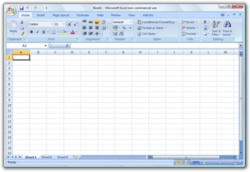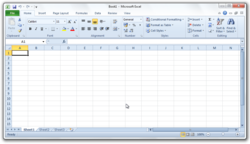Early History
 Microsoft originally marketed a spreadsheet program called Multiplan in 1982. Multiplan became very popular on CP/M systems, but on MS-DOS systems it lost popularity to Lotus 1-2-3. Microsoft released the first version of Excel for the Macintosh on September 30, 1985, and the first Windows version was 2.05 (to synchronize with the Macintosh version 2.2) in November 1987. Lotus was slow to bring 1-2-3 to Windows and by 1988 Excel had started to outsell 1-2-3 and helped Microsoft achieve the position of leading PC software developer. This accomplishment, dethroning the king of the software world, solidified Microsoft as a valid competitor and showed its future of developing GUI software. Microsoft pushed its advantage with regular new releases, every two years or so.
Microsoft originally marketed a spreadsheet program called Multiplan in 1982. Multiplan became very popular on CP/M systems, but on MS-DOS systems it lost popularity to Lotus 1-2-3. Microsoft released the first version of Excel for the Macintosh on September 30, 1985, and the first Windows version was 2.05 (to synchronize with the Macintosh version 2.2) in November 1987. Lotus was slow to bring 1-2-3 to Windows and by 1988 Excel had started to outsell 1-2-3 and helped Microsoft achieve the position of leading PC software developer. This accomplishment, dethroning the king of the software world, solidified Microsoft as a valid competitor and showed its future of developing GUI software. Microsoft pushed its advantage with regular new releases, every two years or so.
Microsoft Windows
1987 Excel 2.0 for Windows
1990 Excel 3.0
1992 Excel 4.0
Introduced auto-fill.
1993 Excel 5.0
With version 5.0, Excel has included Visual Basic for Applications (VBA), a programming language based on Visual Basic which adds the ability to automate tasks in Excel and to provide user-defined functions (UDF) for use in worksheets. VBA is a powerful addition to the application and includes a fully featured integrated development environment (IDE). Macro recording can produce VBA code replicating user actions, thus allowing simple automation of regular tasks. VBA allows the creation of forms and in‑worksheet controls to communicate with the user. The language supports use (but not creation) of ActiveX (COM) DLL's; later versions add support for class modules allowing the use of basic object-oriented programming techniques.
The automation functionality provided by VBA made Excel a target for macro viruses. This caused serious problems until antivirus products began to detect these viruses. Microsoft belatedly took steps to prevent the misuse by adding the ability to disable macros completely, to enable macros when opening a workbook or to trust all macros signed using a trusted certificate.
Versions 5.0 to 9.0 of Excel contain various Easter eggs, including a "Hall of Tortured Souls", although since version 10 Microsoft has taken measures to eliminate such undocumented features from their products.
1995 Excel for Windows 95 (version 7.0)
Included in Office 95. Internal rewrite to 32 bits. Almost no external changes, but faster and more stable.
1997 Excel 97 (version 8.0)
Included in Office 97 (for x86 and Alpha). This was a major upgrade that introduced the paper clip office assistant and featured standard VBA used instead of internal Excel Basic. It introduced the now-removed Natural Language labels.
This version of Excel includes a flight simulator as an Easter Egg.
1999 Excel 2000 (version 9.0)
Included in Office 2000. This was a minor upgrade, but introduced the upgrade to the clipboard where it can hold multiple objects at once. The Office Assistant, whose frequent unsolicited appearance in Excel 97 had annoyed many users, became less intrusive.
2001 Excel 2002 (version 10)
Included in Office XP. Very minor enhancements.
2003 Excel 2003 (version 11)
Included in Office 2003. Minor enhancements, most significant being the new Tables.
2007 Excel 2007 (version 12)
Included in Office 2007. This release was a major upgrade from the previous version. Similar to other updated Office products, Excel in 2007 used the new Ribbon menu system. This was different from what users were used to, but the number of mouse-clicks needed to reach a given functionality were generally fewer (e.g., removing gridlines only required two mouse-clicks instead of five). However, most business users agreed that the replacement of the straightforward menu system with the more convoluted ribbon dramatically reduced productivity.
Added functionality included the SmartArt set of editable business diagrams. Also added was an improved management of named variables through the Name Manager, and much improved flexibility in formatting graphs, which allow (x, y) coordinate labeling and lines of arbitrary weight. Several improvements to pivot tables were introduced.
Also like other office products, the Office Open XML file formats were introduced, including .xlsm for a workbook with macros and .xlsx for a workbook without macros.
Specifically, many of the size limitations of previous versions were greatly increased. To illustrate, the number of rows was now 1,048,576 (220) and columns was 16,384 (214; the far-right column is XFD). This changes what is a valid A1 reference versus a named range. This version made more extensive use of multiple cores for the calculation of spreadsheets; however, VBA macros are not handled in parallel and XLL add‑ins were only executed in parallel if they were thread-safe and this was indicated at registration.
2010 Excel 2010 (version 14)
Included in Office 2010. Minor enhancements and 64-bit support, including the following:
- Multi-threading recalculation (MTR) for commonly used functions
- Improved pivot tables
- More conditional formatting options
- Additional image editing capabilities
- In-cell charts called sparklines
- Ability to preview before pasting
- Office 2010 backstage feature for document-related tasks
- Ability to customize the Ribbon
- Many new formulas, most highly specialized to improve accuracy
2013 Excel 2013 (version 15)
Included in Office 2013. A lot of new tools have been included in this release:
- Improved Multi-threading and Memory Contention
- FlashFill
- PowerView
- PowerPivot
- Timeline Slicer
- Windows App
- Inquire
- 50 new functions
Notes on version numbers
- No MS-DOS version of Excel 1.0 for Windows ever existed: the Windows version originated at the time the Mac version was up to 2.0.
- There is no Excel 6.0, because the Windows 95 version was launched with Word 7. All the Office 95 & Office 4.X products haveOLE 2 capacity — moving data automatically from various programs — and Excel 7 would show that it was contemporary with Word 7.
- Version number 13 was skipped due to superstition
Apple Macintosh
- 1985 Excel 1.0
- 1988 Excel 1.5
- 1989 Excel 2.2
- 1990 Excel 3.0
- 1992 Excel 4.0
- 1993 Excel 5.0 (part of Office 4.X—Motorola 68000 version and first PowerPC version)
- 1998 Excel 8.0 (part of Office 98)
- 2000 Excel 9.0 (part of Office 2001)
- 2001 Excel 10.0 (part of Office v. X)
- 2004 Excel 11.0 (part of Office 2004)
- 2008 Excel 12.0 (part of Office 2008)
- 2011 Excel 14.0 (part of Office 2011)



